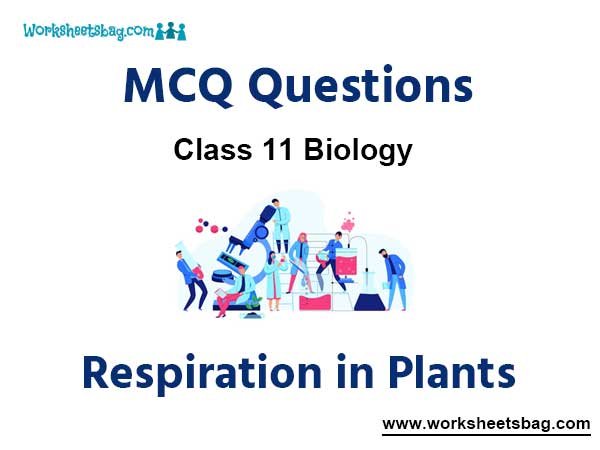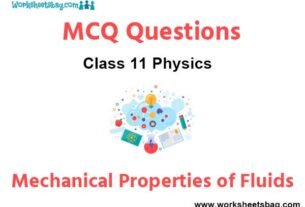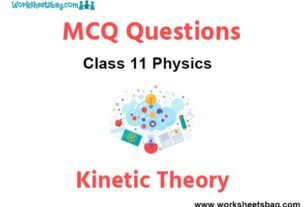Please refer to Respiration in Plants MCQ Questions Class 11 Biology below. These MCQ questions for Class 11 Biology with answers have been designed as per the latest NCERT, CBSE books, and syllabus issued for the current academic year. These objective questions for Respiration in Plants will help you to prepare for the exams and get more marks.
Respiration in Plants MCQ Questions Class 11 Biology
Please see solved MCQ Questions for Respiration in Plants in Class 11 Biology. All questions and answers have been prepared by expert faculty of standard 11 based on the latest examination guidelines.
MCQ Questions Class 11 Biology Respiration in Plants
Question- By which of the following complex, proton is pumped to reach ATP synthase to participate in ATP synthesis?
(a) Cytochrome b6f
(b) Cytochrome c oxidase
(c) Cytochrome a – a3
(d) Cytochrome bc
Answer
A
Question- Respiration is the breakdown of
(a) C-C bonds
(b) C-H bonds
(c) H-H bonds
(d) C-N bonds
Answer
A
Question- Lactic acid is formed by the process of
(a) fermentation
(b) HMP pathway
(c) glycolysis
(d) none of these
Answer
A
Question- Life without air would be
(a) reductional.
(b) free from oxidative damage.
(c) impossible.
(d) anaerobic.
Answer
D
Question- Which of the following is the connecting link between glycolysis and Krebs cycle?
(a) Acetyl CoA
(b) Oxalosuccinic acid
(c) Pyruvic acid
(d) Citric acid
Answer
A
Question- During glycolysis, glucose split into
(a) two pyruvic acid molecules.
(b) two coenzyme A molecules.
(c) two lactic acid molecules.
(d) one lactic acid plus one ethanol molecule.
Answer
A
Question- Oxidative phosphorylation refers to
(a) anaerobic production of ATP.
(b) the citric acid cycle production of ATP.
(c) production of ATP by chemiosmosis.
(d) alcoholic fermentation.
Answer
B
Question- Reduced form of ubiquinone is
(a) ubiquinine
(b) ubiquinol
(c) ubiquitine
(d) all of the above
Answer
B
Question- Which of the following is correct sequence in Kreb’s cycle?
(a) Isocitric acid → Oxalosuccinic acid → a-ketoglutaric acid
(b) Oxalosuccinic acid → Isocitric acid → a-ketoglutaric acid
(c) a-ketoglutaric acid → Isocitric acid → Oxalosuccinic acid
(d) Isocitric acid → a-ketoglutaric acid → Oxalosuccinic acid
Answer
A
Question- In glycolysis, there is one step where NADH + H+ is formed from NAD+, this is when 3- phosphoglyceraldehyde (PGAL) is converted to 1, 3-
bisphosphyglycerate (BPGA). This reaction shows
(a) oxidative dehydrogenation
(b) oxidative phosphorylation
(c) oxidative dehydration
(d) oxidation reduction
Answer
A
Question- Which of the metabolites is common to respiration mediated breakdown of fats, carbohydrates and proteins?
(a) Fructose 1, 6 – bisphosphate
(b) Pyruvic acid
(c) Acetyl CoA
(d) Glucose – 6 – phosphate
Answer
C
Question- How many molecules of ATP are produced during glycolysis?
(a) 2
(b) 4
(c) 6
(d) 8
Answer
A
Question- The reasons for the involvement of different enzyme in each step of glycolysis is that
(a) each step occurs in a different compartment of a cell.
(b) each step occurs in a different cells.
(c) each step involves a different chemical reaction.
(d) each step involves a different change in potential energy.
Answer
C
Question- Inside an active mitochondrion, most electrons follow which pathway ?
(a) Glycolysis → NADH → Oxidative phosphorylation → ATP → O2
(b) Krebs’ cycle → FADH2 → ETS → ATP
(c) ETS → Krebs’ cycle → ATP → O2
(d) Krebs’ cycle → NADH + H+ → Electron transport chain → O
Answer
D
Question- Fermentation takes place
(a) under anaerobic conditions in many prokaryotes and unicellular eukaryotes.
(b) under aerobic conditions in many prokaryotes and unicellular eukaryotes.
(c) under anaerobic conditions in all prokaryotes and unicellular eukaryotes.
(d) under aerobic conditions in all prokaryotes and unicellular eukaryotes.
Answer
A
Question- In alcoholic fermentation
(a) oxygen is the electron acceptor.
(b) triose phosphate is the electron donor while acetaldehyde is the electron acceptor.
(c) triose phosphate is the electron donor while pyruvic acid is the electron acceptor.
(d) there is no electron donor.
Answer
B
Question- In the conversion of pyruvic acid to acetyl coenzyme A,NAD+ is
(a) oxidized
(b) reduced
(c) broken into one-carbon units
(d) isomerized
Answer
B
Question-. Initial step of TCA cycle to yield citric acid starts with the condensation of
(a) acetyl group with OAA & H2O & catalyzed by the enzyme citrate synthase.
(b) acetyl group with pyruvate & H2O & catalysed by the enzyme citrates synthase.
(c) acetyl group with OAA & H2O & is independent of the enzyme.
(d) none of the above.
Answer
A
Question- End products of Krebs cycle from one molecule of glucose is
(a) 2ATP, 2NADH, 2FADH2, CO2 and H2O
(b) 2ATP, 8NADH, 2FADH2, CO2 and H2O
(c) 8ATP, 4NADH, FADH2, CO2 and H2O
(d) ATP, 4NADH, FADH2, CO2 and H2O
Answer
B
Question- In Kreb’s cycle, the conversion of succinyl CoA to succinic acid requires
(a) Acetyl CoA + GDP + iP
(b) CoA + GTP + iP
(c) Acetyl CoA+ GTP + iP
(d) GDP + iP
Answer
D
Question- What is the function of molecular oxygen in cellular respiration?
(a) It causes the breakdown of citric acid.
(b) It combines with glucose to produce carbon dioxide.
(c) It combines with carbon from organic molecules to produce carbon dioxide.
(d) It combines with hydrogen from organic molecules to produce water.
Answer
D
Question- In alcoholic fermentation, NAD+ is produced during the
(a) reduction of acetyldehyde to ethanol.
(b) oxidation of glucose.
(c) oxidation of pyruvate to acetyl coA.
(d) hydrolysis of ATP to ADP.
Answer
A
Question- O2 is used by
(a) citric acid cycle
(b) electron transport chain
(c) substrate level phosphorylation
(d) ATP synthase
Answer
B
Question- In mitochondria, protons accumulate in the
(a) outer membrane
(b) inner membrane
(c) inter membrane space
(d) matrix
Answer
D
Question- How many ATP molecules could maximally be generated from one molecule of glucose, if the complete oxidation of one mole of glucose to CO2 and H2O yields 686 kcal and the useful chemical energy available in the high energy phosphate bond of one mole of ATP is 12 kcal ?
(a) Thirty
(b) Fifty seven
(c) One
(d) Two
Answer
B
Question- Pyruvate kinase enzyme catalyses
(a) first irreversible step of glycolysis
(b) second irreversible step of glycolysis
(c) third irreversible step of glycolysis
(d) fourth irreversible step of glycolysis
Answer
C
Question- Cytochrome oxidase contain
(a) Fe
(b) Mg
(c) Zn
(d) Cu
Answer
A
Question- Acetyl CoA is formed by the breakdown of
(a) fats
(b) fatty acid
(c) glycerol
(d) PGAL
Answer
B
Question- In some succulent plants like Opuntia the R. Q. is zero because
(a) CO2 is released without any absorption of O2.
(b) O2 is absorbed but CO2 is not released.
(c) there is often compensation point in these plants due to thick phylloclades.
(d) none of the above
Answer
B
Question- In glycolysis, glucose molecule is converted into
(a) PEP
(b) RuBP
(c) acetyl CoA
(d) pyruvic acid
Answer
D
Question- Which one of the following is not included in glycolysis ?
(a) Substrate level phosphorylation occur.
(b) The end products are CO2 and H2O.
(c) ATP is formed.
(d) ATP is used.
Answer
B
Question-The common phase between aerobic and anaerobic respiration is called
(a) tricarboxylic acid cycle
(b) Oxidative phosphorylation
(c) Embden, Meyerhof, Parnas cycle (Glycolysis)
(d) Fermentation
Answer
D
Question- Energy accumulate in ATP in
(a) disulphide bond
(b) hydrogen bonds
(c) high energy phosphate bond
(d) ester bond
Answer
C
Question- Conversion of phosphoglyceraldehyde to 1, 1-biphosphoglyceric acid is a
(a) primary reaction only
(b) redox reaction only
(c) primary and redox reaction
(d) substrate level phosphorylation reaction
Answer
C
Question- The chemiosmotic coupling hypothesis of oxidative phosphorylation proposes that adenosine triphosphate (ATP) is formed because
(a) high energy bonds are formed in mitochondrial proteins.
(b) ADP is pumped out of the matrix into the intermembrane space.
(c) a proton gradient forms across the inner membrane.
(d) there is a change in the permeability of the inner mitochondrial membrane toward adenosine diphosphate (ADP).
Answer
C
Question- In which one of the following reactions, substrate level phosphorylation does not occur?
(a) 1, 3-biphosphoglyceric acid → 3, phosphoglyceric acid
(b) Glucose-6-phosphate → Fructose 6 phosphate
(c) Succinyl CoA → Succinic acid
(d) Phosphoenol pyruvic acid → pyruvic acid
Answer
B
Question- Which of the following processes make direct use of oxygen?
(a) Glycolysis
(b) Fermentation
(c) Electron transport
(d) Krebs citric acid cycle
Answer
C
Question- If hexokinase, an enzyme that catalyzes the first step reaction in glycolysis is blocked then what will be its impact on glycolytic pathway ?
(a) Glycolysis will speed up.
(b) Glycolysis will slow down.
(c) Glycolysis will stop.
(d) Glycolysis will occurs normally.
Answer
C
Question- Cytochrome oxidase is a/an
(a) exoenzyme
(b) endoenzyme
(c) proenzyme
(d) coenzyme
Answer
B
Question- Glycolysis occurs in
(a) mitochondria
(b) chloroplast
(c) cytoplasm
(d) peroxisome
Answer
C
Question- Respiration substrates are
(i) the compounds that are oxidized to utilise energy.
(ii) the compounds that are reduced to utilise energy.
(iii) the compounds that are oxidized to release energy.
(iv) the compounds that are reduce to release energy.
(a) (i) only
(b) both (i) and (ii)
(c) (iii) only
(d) Both (iii) and (iv)
Answer
C
Question- Anaerobic respiration, after glycolysis is also called as
(a) fermentation
(b) fragmentation
(c) restoration
(d) multiplication
Answer
A
Question- In alcoholic fermentation, NAD+ is produced during the
(a) reduction of acetyldehyde to ethanol.
(b) oxidation of glucose.
(c) oxidation of pyruvate to acetyl coA.
(d) hydrolysis of ATP to ADP.
Answer
A
Question- Photorespiration in C3 plants starts from
(a) phosphoglycerate
(b) phosphoglycolate
(c) glycerate
(d) glycine
Answer
A
Question- For bacteria to continue growing rapidly when they are shifted from an environment containing O2 to an anaerobic environment, they must
(a) produce more ATP per mole of glucose during glycolysis.
(b) produce ATP during oxidation of glucose.
(c) increase the rate of glycolysis.
(d) increase the rate of TCA cycle.
Answer
C
Question- Which one is correct sequence in glycolysis?
(a) G 6-P → PEP → 3-PGAL → 3-PGA
(b) G 6-P → 3-PGAL → 3-PGA → PEP
(c) G 6-P → PEP → 3-PGA → 3-PGAL
(d) G 6-P → 3-PGA → 3-PGAL → PEP
Answer
A
Question- An enzymes of TCA cycle are located in the mitochondrial matrix except one which is located in inner mitochondrial membrane in eukaryotes and in cytosol in prokaryotes. This enzyme is
(a) Succinate dehydrogenase
(b) Lactate dehydrogenase
(c) Isocitrate dehydrogenase
(d) Malate dehydrogenase
Answer
A
Question- Which one of the following is complex V of the ETS of inner mitochondrial membrane?
(a) NADH dehydrogenase
(b) ATP synthetase
(c) Succinate dehydrogenase
(d) Ubiquinone
Answer
B
Question- In respiration, largest amount of energy is produced in
(a) anaerobic respiration
(b) Krebs’ cycle
(c) glycolysis
(d) none of the above
Answer
D
Question- Which of the following statements (i to v) regarding glycolysis are correct.
(i) It is ten enzymatic reactions that convert a six-carbon molecule to a three carbon pyruvate and result in a net gain of 2 ATP molecules.
(ii) Glucose undergoes partial oxidation to form one molecule of pyruvic acid.
(iii) Glucose is phosphorylated to give rise to glucose – 6 – phosphate by the activity of the enzyme phosphofructokinase.
(iv) The scheme of glycolysis was given by Gustav Embden, Otto Morrison, and J. Parnas and is often referred to as the EMP pathway.
(v) ATP is utilized at two steps: first in the conversion of glucose into glucose 6- phosphate & second in the conversion of fructose – 6- phosphate to fructose 1, 6-disphosphate.
(a) (i), (iv) and (v)
(b) (iii) and (v)
(c) (iv) and (v)
(d) (ii) and (iv)
Answer
A
Question- Single turn of citric acid cycle yields
(a) 2FADH2, 2NADH2, 2GTP
(b) 1FADH2, 2NADH2, 1GTP
(c) 1FADH2, 4NADH2, 1GTP
(d) 1FADH2, 1NADH2, 2GTP
Answer
C
These questions consist of
two statements, each printed as Assertion and Reason. While answering these questions, you are required to choose any one of the following five responses.
(a) If both Assertion and Reason are correct and the Reason is a correct explanation of the Assertion.
(b) If both Assertion and Reason are correct but Reason is not a correct explanation of the Assertion.
(c) If the Assertion is correct but Reason is incorrect.
(d) If both the Assertion and Reason are incorrect.
(e) If the Assertion is incorrect but the Reason is correct.
Question- Assertion : Stomata are absent in submerged hydrophytes.
Reason : Respiration occurs by means of air chambers in submerged plants.
Answer
B
Each of these questions
contains an Assertion followed by Reason. Read them carefully and answer the question on the basis of following options. You have to select the one that best describes the two statements.
(a) If both Assertion and Reason are correct and Reason is the correct explanation of Assertion.
(b) If both Assertion and Reason are correct, but Reason is not the correct explanation of Assertion.
(c) If Assertion is correct but Reason is incorrect.
(d) If both the Assertion and Reason are incorrect.
Question- Assertion : Glycolysis is the first step of respiration in which glucose completely breaks into CO2 and H2O.
Reason : In this process, there is net gain of twenty four molecules of ATP.
Answer
B
Question- Assertion : Glycolysis occurs in cytoplasm.
Reason : Enzymes for glycolysis are found in cytoplasm. It is common in aerobic/anaerobic respiration.
Answer
A
Question- Assertion : The inner membrane of mitochondria contains systems involving electron transport.
Reason : The mitochondrial matrix contains enzymes of Kreb’s cycle.
Answer
B


